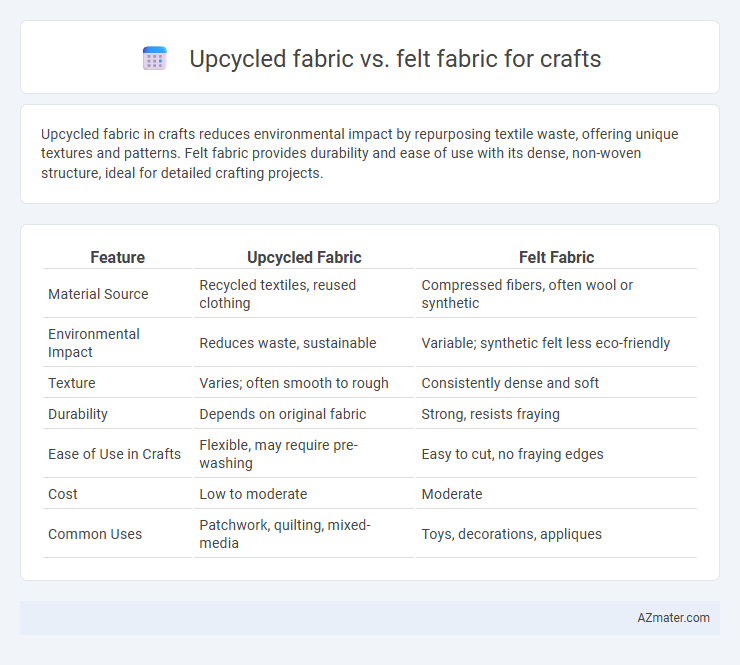Upcycled fabric in crafts reduces environmental impact by repurposing textile waste, offering unique textures and patterns. Felt fabric provides durability and ease of use with its dense, non-woven structure, ideal for detailed crafting projects.
Table of Comparison
| Feature | Upcycled Fabric | Felt Fabric |
|---|---|---|
| Material Source | Recycled textiles, reused clothing | Compressed fibers, often wool or synthetic |
| Environmental Impact | Reduces waste, sustainable | Variable; synthetic felt less eco-friendly |
| Texture | Varies; often smooth to rough | Consistently dense and soft |
| Durability | Depends on original fabric | Strong, resists fraying |
| Ease of Use in Crafts | Flexible, may require pre-washing | Easy to cut, no fraying edges |
| Cost | Low to moderate | Moderate |
| Common Uses | Patchwork, quilting, mixed-media | Toys, decorations, appliques |
Understanding Upcycled Fabric: Definition and Benefits
Upcycled fabric refers to materials repurposed from old textiles or discarded garments, transformed into new craft supplies, reducing waste and environmental impact. This fabric retains unique textures and patterns, offering creative versatility and sustainability advantages over conventional felt fabric. Felt fabric, while popular for crafting due to its uniform thickness and ease of cutting, lacks the eco-friendly appeal and distinct aesthetic character found in upcycled fabric.
What is Felt Fabric? Types and Uses in Crafting
Felt fabric is a dense material made by matting and compressing fibers, typically wool or synthetic, without weaving, offering durability and ease of shaping for diverse crafting projects. Types of felt include wool felt, acrylic felt, and eco-friendly recycled felt, each providing different textures and strengths suited for detailed applique, padding, and decorative items. In crafting, felt fabric is favored for its stiffness and natural resistance to fraying, making it ideal for making ornaments, toys, and intricate designs that require structural stability, contrasting with the more sustainable but less uniform texture of upcycled fabric.
Eco-Friendly Aspects: Upcycled vs Felt Fabric
Upcycled fabric repurposes existing textiles, significantly reducing waste and conserving resources by diverting materials from landfills, making it a highly sustainable option for eco-conscious crafters. Felt fabric, often made from natural fibers like wool or recycled synthetic fibers, offers biodegradability and a low-impact manufacturing process, but may involve energy-intensive production if synthetic materials dominate. Opting for upcycled fabric minimizes environmental footprint by reusing materials, while sustainable felt provides durability and compostability, positioning both as eco-friendly textiles with distinct sustainability benefits.
Durability and Strength: Which Fabric Lasts Longer?
Upcycled fabric often retains the durability of its original material, making it strong and long-lasting for various craft projects, especially when sourced from high-quality textiles like denim or canvas. Felt fabric, while versatile and easy to work with, typically has a softer texture and may wear down more quickly under stress or frequent use. For crafts requiring prolonged durability and strength, upcycled fabric generally provides a longer-lasting option compared to felt.
Texture and Aesthetic: Comparing Visual Appeal
Upcycled fabric offers a unique texture characterized by its varied patterns and tactile irregularities, giving each craft project a distinct, eco-friendly aesthetic appeal. Felt fabric provides a smooth, consistent surface with a soft, dense texture that enhances the visual uniformity and bold color vibrancy in handmade crafts. Choosing between upcycled fabric and felt fabric depends on whether the desired craft aesthetic favors individuality and sustainability or sleek, polished simplicity.
Versatility in Craft Projects: Upcycled vs Felt
Upcycled fabric offers unmatched versatility in craft projects due to its wide range of textures, colors, and patterns sourced from repurposed textiles, making each piece unique and eco-friendly. Felt fabric provides consistent thickness and durability, ideal for detailed work like applique, ornaments, and structured shapes, excelling in ease of cutting and sewing without fraying. While felt ensures uniformity and precision, upcycled fabric enhances creativity through its diverse and sustainable material options.
Cost Comparison: Affordability for Crafters
Upcycled fabric often offers a more cost-effective option for crafters due to its lower price point and availability from recycled materials, reducing both expenses and environmental impact. Felt fabric, while generally affordable, tends to have a consistent cost because it is manufactured specifically for crafting purposes, often making it pricier than reclaimed textiles. Choosing upcycled fabric allows budget-conscious crafters to access unique textures and patterns without sacrificing quality or affordability.
Ease of Working: Cutting, Sewing, and Shaping Differences
Upcycled fabric is typically easier to cut and sew due to its varied textures and flexibility, allowing for creative shaping and diverse craft applications. Felt fabric, made from compressed fibers, offers consistent thickness and stiffness, making it simple to cut cleanly but sometimes challenging to shape or sew due to less stretch and fraying resistance. For projects requiring precise cutting and structural integrity, felt provides reliable performance, while upcycled fabric excels in versatility and adaptability for unique designs.
Availability and Sourcing: Where to Get Each Fabric
Upcycled fabric is often sourced from thrift stores, textile recycling centers, and online marketplaces specializing in sustainable materials, making it widely available but dependent on seasonal or seasonal textile waste. Felt fabric can be purchased from craft stores, fabric shops, and large retailers both online and offline, offering consistent availability in various thicknesses and colors specifically designed for crafting purposes. While upcycled fabric supports eco-friendly projects by reusing material, felt fabric provides reliable sourcing for standard crafting needs with ready-to-use sheets and rolls.
Best Craft Ideas: Upcycled Fabric or Felt for Your Next Project
Upcycled fabric offers a sustainable and eco-friendly option with unique patterns and textures ideal for personalized craft projects like patchwork quilts and fabric collages. Felt fabric provides a soft, sturdy, and versatile material perfect for detailed crafts such as ornaments, appliques, and children's toys due to its easy-to-cut and non-fraying nature. Choosing between upcycled and felt fabrics depends on the project's sustainability goals and desired texture, making both excellent choices for creative and impactful craft ideas.

Infographic: Upcycled fabric vs Felt fabric for Craft
 azmater.com
azmater.com